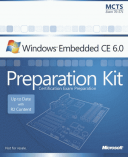Книга: Microsoft Windows Embedded CE 6.0 Exam Preparation Kit
Lesson 4: Implementing an Interrupt Mechanism in a Device Driver
Interrupts are notifications generated either in hardware or software to inform the CPU that an event has occurred that requires immediate attention, such as timer events or keyboard events. In response to an interrupt, the CPU stops executing the current thread, jumps to a trap handler in the kernel to respond to the event, and then resumes executing the original thread after the interrupt is handled. In this way, integrated and peripheral hardware components, such as system clock, serial ports, network adapters, keyboards, mouse, touchscreen, and other devices, can get the attention of the CPU and have the kernel exception handler run appropriate code in interrupt service routines (ISRs) within the kernel or in associated device drivers. To implement interrupt processing in a device driver efficiently, you must have a detailed understanding of Windows Embedded CE 6.0 interrupt handling mechanisms, including the registration of ISRs in the kernel and the execution of interrupt service threads (ISTs) within the Device Manager process.
After this lesson, you will be able to:
? Implement an interrupt handler in the OEM adaptation layer (OAL).
? Register and handle interrupts in a device driver interrupt service thread (IST).
Estimated lesson time: 40 minutes.
- Chapter 6 Developing Device Drivers
- JDBC Туре 4 DRIVER
- Test Driver Code
- Lesson Summary
- Creating and Deleting Device Objects
- Installing Proprietary Video Drivers
- Implementing Quotas
- Lesson 2: Implementing System Applications
- Introduction to Serial Devices
- Devices
- The Disk as a Storage Device
- Implementing RAID on Windows Server 2012 R2




